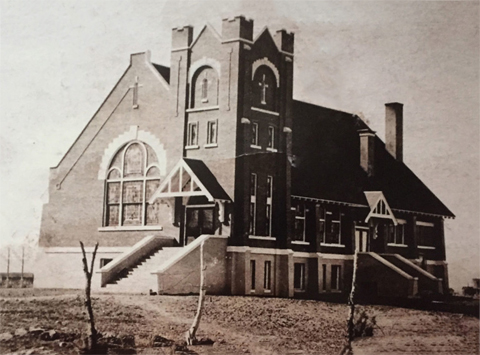By: Paige Ogden
Each year, Mr. Luke Waldron’s 8th grade class participates in an assignment to research and write a historical paper about Oneida County for the Malad Valley Welsh Festival. The histories are judged, and awards are presented by the Malad Valley Welsh Foundation.
The winner of the 2013 8th grade History Project Award for the most accurate paper was awarded to Paige Ogden with a history of the Daniels Valley. The following is her report:
History
The community of Daniels was founded in 1830-1840 by Daniel M. Daniels. The old dam was built in 1918. The old school house was built in 1913. It is an interesting story of how Daniels was settled in the 1800’s. Daniels lost some of his horses and cattle. He found them in a meadow on the east side of Daniels, grazing on the luscious grass and decided that this was where he was going to settle.
The Rock House
If you look at the rock house, it is aligned with the North Star – not north by the compass. The house walls are about 10 inches thick and to build it was a real feat. Without modern equipment, it had two rooms on the main floor and a rope ladder led up to the attic. There may have been a lean-to room on the left side. In the early 1930’s the Bill Stowell family and Bud, Isabel, and Johnny lived there. Mrs. Stowell operated a little store. People in West Daniels contributed a little money each month to pay the bill and then they could use the phone for emergencies. If there were important phone messages for anyone in the valley, someone in the Stowell family would take the word to whomever it was for. For some reason, the Stowell family moved out of the farm, including the house when my great aunt, Donna Burrie, was in the fifth grade and her dad bought the farm, including the house. He tore down all the buildings but luckily he left the old rock house standing.
The Candy Kitchen
The candy kitchen is located in the Sublett Canyon. The homesteader that built the candy kitchen had originally come here from New Jersey. He had been a candy maker where he originated from. While he was settling his homestead, he made candy in the dugout cabin and brought it to Malad to sell, to make money to support his family. The cabin (dug out) was built back into the side of a hill. The walls were constructed of shale rock blocks and had a wood and dirt roof. The remains of the cabin can still be seen today.
Daniels School
There were two, 2-room school houses in Daniels, one on each side of the valley. The East one is still standing and the west side building was located on the hill directly north of the little Malad springs. Each school had two teachers, grades one through four in one room and five through eight in the other room. The teachers lived with the families in the valley during the school year. The teachers and the students walked, rode horses or rode in a wagon to get to school. After the eighth grade, the students came to Malad to go to high school.
Farms
All of the farms in the valley originated as homesteads. The government gave each family 160 acres. But before they could own the land, they had to build a cabin, tear out all of the sagebrush and native plant life, plow the ground, and raise a crop of grain. If they could do this in five years, they were given title to the ground. All the farming was done by hand or with horses. The main crop that they raised was wheat.
The Head of Malad
Daniels’ Valley is sometimes called the Head of Malad, because the Malad River originates there, out of the Malad spring.
What is in Daniels Today?
Daniel’s Valley is largely unchanged, except that most of the homestead buildings are gone. The ground still raises grain and most of the operators are descendants of the original homesteaders. The valley also boasts of Daniel’s Reservoir, a trophy trout fishery.
______________
Source: Joe Burrie, Personal Interview, March 15, 2013
